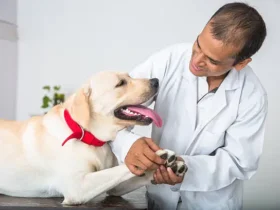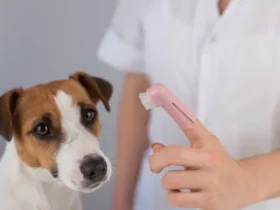How to Trim Your Dog’s Nails: A Complete Guide for Pet Owners
Trimming your dog’s nails is an essential part of their grooming routine and overall health. Long nails can lead to discomfort, affect your dog’s ability to walk properly, and even cause injury. Many pet owners feel anxious about nail trimming, but with the right tools and techniques, you can confidently handle this task at home. In this guide, we’ll cover everything you need to know about trimming your dog’s nails, from understanding nail anatomy to step-by-step trimming instructions.
Why Nail Trimming Is Important for Dogs
Keeping your dog’s nails trimmed is crucial for their well-being. Overgrown nails can cause a range of issues, including:
- Pain and Discomfort: Long nails can cause your dog to shift their weight unnaturally, leading to discomfort and pain in their paws, legs, and joints.
- Difficulty Walking: Nails that are too long may touch the ground while your dog walks, making it difficult for them to walk comfortably. This can lead to limping or changes in gait.
- Nail Breakage: Overgrown nails are more likely to break or split, which can be painful and lead to infections.
- Damage to Furniture: Long nails can scratch and damage floors, carpets, and furniture.
- Posture Problems: When a dog’s nails are too long, they may place weight on the wrong parts of their feet, leading to posture problems and joint strain over time.
- Injuries: Long nails can easily get caught in carpets or other surfaces, causing injuries like sprains or breaks.
For these reasons, it’s important to regularly trim your dog’s nails to maintain their health and comfort.
How Often Should You Trim Your Dog’s Nails?
How often you need to trim your dog’s nails depends on several factors, including their activity level, breed, and the surface they walk on regularly. As a general rule:
- Active Dogs: Dogs that walk or run on hard surfaces like concrete may wear their nails down naturally and require less frequent trims.
- Less Active Dogs: Dogs that spend more time indoors or on soft surfaces (like grass or carpet) will need more frequent nail trims because their nails won’t wear down as much.
Check your dog’s nails every two to three weeks to see if they need trimming. A good indicator that it’s time for a trim is if you hear your dog’s nails clicking on the floor as they walk.
Understanding Your Dog’s Nail Anatomy
Before you begin trimming your dog’s nails, it’s important to understand their anatomy. Dogs’ nails consist of:
- The Nail: The hard, outer part of the nail is what you will be trimming.
- The Quick: Inside the nail is a sensitive area called the “quick,” which contains blood vessels and nerves. Cutting into the quick can cause pain and bleeding.
In light-colored nails, the quick is often visible as a pink area, making it easier to avoid. For dogs with dark nails, the quick is harder to see, so you’ll need to take extra care when trimming.
Choosing the Right Tools for Nail Trimming
Using the right tools is essential for a safe and effective nail trim. Here are the tools you’ll need:
- Dog Nail Clippers: There are two main types of dog nail clippers:
- Scissor-Style Clippers: These are great for larger dogs with thick nails.
- Guillotine-Style Clippers: These work well for smaller dogs and those with thinner nails.
- Nail Grinder: A nail grinder (also known as a Dremel tool) files down the nail rather than cutting it. This tool is good for dogs who are sensitive to clippers or for smoothing rough edges after clipping.
- Styptic Powder: If you accidentally cut the quick, styptic powder can help stop the bleeding quickly. Keep this on hand as a precaution.
- Treats: Positive reinforcement is key! Use treats to reward your dog throughout the process to keep them calm and cooperative.
Step-by-Step Guide to Trimming Your Dog’s Nails
Follow these steps to safely and effectively trim your dog’s nails at home.
1. Prepare Your Dog and Environment
- Choose a Quiet Space: Find a calm, quiet area where your dog feels comfortable. This helps reduce anxiety and keeps them relaxed during the process.
- Gather Your Tools: Have your nail clippers, styptic powder, and treats within easy reach.
2. Get Your Dog Comfortable
- Handle Their Paws: If your dog is not used to having their paws touched, spend some time gently handling their feet before you start trimming. This helps them get used to the sensation.
- Positive Reinforcement: Use treats to reward your dog for staying calm. Keep the atmosphere positive to prevent stress or anxiety.
3. Hold Your Dog’s Paw Securely
- Gently hold your dog’s paw and isolate the nail you’re going to trim. Hold their paw firmly but gently to prevent any sudden movements.
- If your dog has long hair, push the fur back so you can clearly see the nail.
4. Trim the Nail
- Position the Clippers: Place the nail clippers at a 45-degree angle and trim a small portion of the nail at a time.
- Avoid the Quick: Cut slowly and stop before you reach the quick. If your dog has light-colored nails, the quick will be visible. For dogs with dark nails, trim small amounts to avoid cutting into the quick.
5. Check for the Quick in Dark Nails
For dark nails, trim small amounts of the nail and observe the cut surface after each trim. When you start to see a small, black dot in the center of the nail, stop trimming—that’s the quick.
6. Use a Nail Grinder for Finishing Touches
After trimming, you can use a nail grinder to smooth any rough edges. Some dogs prefer grinders because they’re less likely to pinch or hurt compared to clippers.
7. Reward Your Dog
After trimming each nail, reward your dog with treats and praise. This helps create a positive association with nail trimming.
8. Stop If Your Dog Is Anxious
If your dog becomes anxious or fidgety, take a break. You don’t have to trim all the nails in one sitting. Take your time and trim only what your dog is comfortable with.
What to Do If You Cut the Quick
Accidentally cutting the quick is a common concern, especially for dogs with dark nails where the quick is harder to see. If you do cut the quick:
- Stay Calm: Your dog may yelp or pull away, but it’s important to stay calm to avoid alarming them further.
- Apply Styptic Powder: Use styptic powder to stop the bleeding. Press a small amount onto the nail and hold it there for a few seconds.
- Reassure Your Dog: Comfort your dog and give them treats to help calm them down.
- Pause the Trimming: If the quick is cut, it’s best to pause the nail trimming for the day and try again later when your dog is calm.
Tips for Successful Nail Trimming
- Start Early: Introduce your dog to nail trimming when they are young. The earlier they get used to it, the easier it will be to trim their nails as they grow older.
- Take Breaks: If your dog is nervous or resistant, take breaks and try again later. You don’t have to trim all the nails in one session.
- Use Positive Reinforcement: Reward your dog with treats and praise throughout the process to help them stay calm and associate nail trimming with positive experiences.
- Check for Signs of Stress: Pay attention to your dog’s body language. If they seem overly anxious, take it slow and reassure them with a gentle voice and treats.
- Consider Professional Grooming: If you’re uncomfortable trimming your dog’s nails or if your dog becomes too anxious, consider taking them to a professional groomer or vet for nail trims.
When to Seek Professional Help
There are times when it’s best to leave nail trimming to the professionals, such as:
- Extremely Overgrown Nails: If your dog’s nails are extremely long or curling, it’s best to let a vet or groomer handle the first trim.
- Nail Disorders: If your dog has a nail disorder or injury, a professional groomer or vet should trim their nails to avoid further injury.
- Nervous Dogs: Some dogs become highly anxious or aggressive during nail trims. In these cases, professional groomers or vets may have the experience and tools to handle the situation safely.
Conclusion
Trimming your dog’s nails is an important part of their overall health and hygiene. With the right tools, patience, and practice, you can trim your dog’s nails safely at home. Remember to take it slow, use positive reinforcement, and trim only small portions of the nail at a time to avoid cutting the quick. If you’re ever unsure or uncomfortable with trimming your dog’s nails, seek help from a professional groomer or veterinarian to ensure your dog stays healthy and comfortable.
By making nail trimming a regular.











Leave a Reply